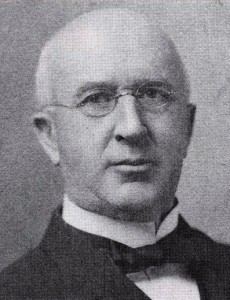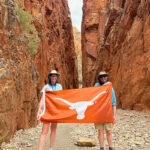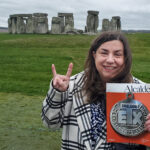The First Snow Day
Snow days in Austin? They’re rare. They happen only once in a blue moon. Some put the odds at a snowball’s chance in, well, you get the idea.
When Old Man Winter makes one of his infrequent visits to the capital of Texas, it’s a given that the city and University will close, at least for a while. But the success of UT’s first snow day relied on some daring by a group of students, and a University president with a sense of humor.
In February 1899, an exceptionally strong Arctic surge abruptly disturbed an otherwise quiet winter across most of North America. Dubbed the Great Blizzard of 1899, it brought record cold to the South, including a 1 degree below zero temperature in Austin. More than 35 inches of snow fell in Washington, D.C., and white-out conditions were experienced as far south as Tampa, Fla.
On the morning of Saturday, Feb. 11, 1899, sleepy University of Texas students awoke to find Austin cloaked in six inches of new snow. In a time before long-range forecasts, pinpoint Doppler radar, or the Weather Channel, the snowfall was completely unexpected.
“In the old days at Varsity, snow was a rarer thing than ice cream at B. Hall,” wrote Fritz Lanham, the first editor of The Texan student newspaper, who lived in Brackenridge Hall, or “B. Hall,” the University’s first residence hall for men. “Imagine, therefore, the surprise of the students when they rose from their larks to find the earth receiving a breakfast of heavenly flakes!”
It was also a class day. For the first few decades of the University’s existence, classes met six days a week, either on Monday, Wednesday, Friday, or Tuesday, Thursday, Saturday. Since most of the faculty and UT’s 594 students lived on or within walking distance of the campus, and as there was no radio, television, or Internet to broadcast a school closure, Saturday classes began as usual, promptly at 9 a.m.
Of course, the snow was a distraction. Students gazing from the windows of the Victorian Gothic old Main Building (where the Main Building and Tower stand today) couldn’t help but think that such an unusual day ought not be spent in a classroom.
The denizens of B. Hall agreed. As the snow fell, so did their interest in academic pursuits. Schemes hatched in the minds of the Hall’s residents as snowballs formed in their hands, and gradually a relationship of cause and effect between the two was realized. The only piece missing was the official suspension of classes, which could only be granted by the University president.
After some discussion, a small band set out from B. Hall. Led by Walter Schreiner and Walter Monteith, both members of the football team, they boldly made their way up the hill to the Main Building, climbed the south steps, passed through the front entrance, and then immediately turned left to enter the sanctum sanctorum, the office of UT President George Winston.
Their mission wasn’t a secret, and others were eager to join the cause. By the time the group reached the Main Building, it had snowballed into a crowd, and each student carried an armful of frosty white pellets to “bolster up this declaration.”
The mob of students squeezed into the president’s office, where Schreiner and Monteith, respectfully, but firmly, presented their request for a day off. Winston eyed the students, spied the arsenal of snowballs, but didn’t panic. He’d been in this situation before.
 George T. Winston was appointed UT’s first full-time president in 1896, and succeeded Leslie Waggener, who was then both Chairman of the Faculty and President ad interim. A native of North Carolina, Winston attended the Naval Academy for two years and was head of his class before persistent and serious nausea at sea forced him to transfer to Cornell University.
George T. Winston was appointed UT’s first full-time president in 1896, and succeeded Leslie Waggener, who was then both Chairman of the Faculty and President ad interim. A native of North Carolina, Winston attended the Naval Academy for two years and was head of his class before persistent and serious nausea at sea forced him to transfer to Cornell University.
After graduation, he returned to his home state, joined the faculty of the University of North Carolina, and 16 years later was appointed president. In June 1896, Winston was invited to deliver the commencement address at The University of Texas, and so impressed the Board of Regents he was asked to head the Austin campus later that same year.
Early in 1897, Winston received a request from the students who believed that March 2, Texas Independence Day, should be an annual University holiday.
But Winston grew up on the East coast and spent time at Annapolis; he neither understood nor shared the affinity Texans had for the second day of March, and flatly refused the petition. The only Independence Day he recognized was on July 4.
Undaunted, the students signed a bond to borrow one of two brass cannons then in front of the State Capitol, rolled it a mile to the campus, and on March 2, fired it repeatedly in front of the Main Building. Classrooms emptied, faculty joined the students in making patriotic speeches, and a very reluctant President Winston was brought before the assembly to say a few words. His comments were paraphrased:
“I was born in the land of liberty, rocked in the cradle of liberty, nursed on the bottle of liberty, and I’ve had liberty preached to me all my life. But Texas University students take more liberty than anyone I’ve ever come in contact with.”
Two years later, facing a legion of anxious students armed with melting snowballs, a wiser President Winston smiled. “Certainly, young gentlemen. It seldom snows at this latitude, and you are at liberty to enjoy it.”
As the news hurried through the halls of the Main Building, classrooms were opened “and the prisoners liberated.” The only dissenting voice came from English professor Mark Liddell, who was unhappy at the interruption of his lecture. Though he may have been a bit warm under the collar, his temperament was surely cooled by the volley of snowballs fired in his direction.
The rest of the day was spent in a great snowball battle, in which the residents of B. Hall held their own against the combined forces of the remaining students and faculty.
Top, co-eds throwing snowballs, from the 1926 Cactus Yearbook. Bottom, George T. Winston. Learn more about UT’s past at UT History Central.


















No comments
Be the first one to leave a comment.